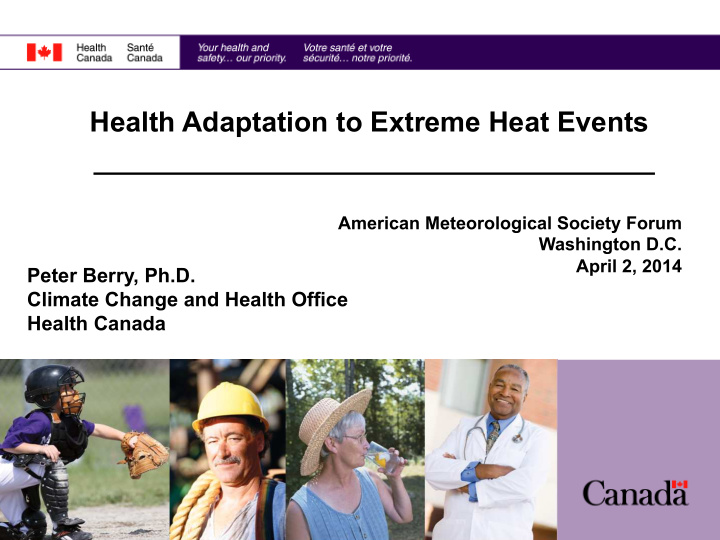



Health Adaptation to Extreme Heat Events American Meteorological Society Forum Washington D.C. April 2, 2014 Peter Berry, Ph.D. Climate Change and Health Office Health Canada
Health Risks in Canada from Climate Change Dangerous travelling c conditions Permafrost Pe Cha hanges i in d drinking w water melt d damaging quality a and q quantity infras infrastruct ructure ures Food s security - - cha hanging a animal Heat–r Hea t–rel elated ed dis distribut ributions ions illnesses a and deaths hs Health i h impacts f from more s severe s storms Psycho hosocial Wa Water-borne Expansion o of L Lyme impacts f from diseases f from Disease v vector drought hts fl floods Respiratory i illnesses from f forest f fires http://publications.gc.ca/collections/ collection_2008/hc-sc/H128-1-08-528E.pdf
Heat Projections for Select Canadian Cities Health Canada, 2012 3
Factors ¡that ¡Increase ¡Vulnerability ¡ Health Canada, 2011 4
Toward Health Adaptation Action Adaptation Action Legislation Groundwork Departmental Assessments development Adaptation research Recognition Public outreach Conceptual tools Increased Surveillance/monitoring Stakeholder awareness Infrastructure/technology networking Program evaluations Policy Financial support recommendations Medical interventions Lesnikowski, 2013 5
EM Action With and Without “Adaptation” EM Action EM + Adaptation HRVA integrating climate Hazard Risk change + CC assessments VulnerabiliytAssessment Disaster mitigation Disaster mitigation informed by CC drivers (e.g, UHI) Disaster plans – informed by Disaster planning CC (eg., simultaneous events) TTX with CC scenario Table top exercises Surveillance Monitoring new health risks Response and recovery Activate surge capacity Partners with CC knowledge, Increasing planning capacity staff aware of CC risks 6
Developing Heat Resilient Communities and Individuals Goal: In partnership with provinces and communities, expand HARS to increase the resilience of Canadians to the health risks of extreme heat events Four areas of activity : i) Heat health messaging to support personal adaptation ii) Heat-Health Science: Address critical knowledge gaps iii) Clinical training: Enable health professionals to better advise, diagnose and treat their clients iv) Expansion of HARS to communities across Canada 7
Heat ¡Alert ¡and ¡Response ¡Systems ¡ 8 Health Canada, 2011
Best Communication Practices Audience Message Message delivery Perceptions Clear Media Interpersonal networks Challenges Tailored Community & group events Heat-vulnerabilities Address barriers to action Collaborative Needs Timing Adaptation 9
Challenges - Addressing Barriers to Adaptation Examples of Challenges Seniors Face in Adapting to Extreme Heat Events 10
Challenges - Contradictory Messages Extreme Sun Air Physical WNv Environ. Heat Safety Quality Activity Safety Initiatives use air conditioners & fans vs. don ’ t use air conditioners visit tree-shaded areas vs. stay indoors/ out of shaded areas wear breathable, loose clothing vs. wear tightly woven clothing reduce outdoor physical activity vs. commute by cycling/ be active open windows vs. close windows 11
Challenges – Met Data to Protect Health Potential UHI effect in Edmonton, Alberta August 18, 2008 12
¡ ¡ ¡ ¡ ¡Health ¡Care ¡Facility ¡Resiliency ¡Toolkit ¡ 1 1) Facilitator ¡Presenta;on ¡ 2 2 2) ¡Health ¡Care ¡Facility ¡ Resiliency ¡Checklist ¡ 3 3) ¡Best ¡Prac;ces ¡and ¡ Resources ¡ http://www.greenhealthcare.ca/ 13
THANK-YOU For ¡more ¡informa;on, ¡please ¡contact: ¡ ¡ ¡ Peter Berry Peter.Berry@hc-sc.gc.ca www.healthcanada.gc.ca/cc ¡ ¡ ¡ ¡ ¡ 14
Recommend
More recommend